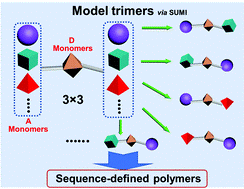Xu and co-workers utilize model trimers as a guide for discrete oligomer synthesis.
Biomacromolecules such as DNA and proteins exhibit perfect sequence precision which allows them to fulfill a number of biological functions. A long-lasting challenge in polymer chemistry is to mimic these biopolymers through synthetic analogues. In particular, single unit monomer insertion technique has emerged as a powerful tool to synthesize sequence-defined polymers with perfect uniformity. Key to this approach is the alternating addition of electron-donor and acceptor monomers which can be utilized to prepare long polymer chains through sequential monomer radical additions occurring one unit at a time. Despite notable progress in the last decades, such alternative and sequential monomer additions often produce complex radical reaction kinetics which makes the formation of diverse polymer sequences challenging. To this end, simplifying reaction processes and establishing simple reaction kinetics is essential to bring a rapid and reliable synthesis. In this work, Xu and co-workers describe a methodology to address this challenge by employing model trimers as a guide for the synthesis of sequence-defined polymers. Central to the design is the sequential and alternating PET-RAFT SUMI technology which enables the acquisition of full kinetic data, thus providing a very useful insight over both reaction rates and yields. Four different families of α,β-disubstituted vinyl monomers (N-phenylmaleimide (PMI), fumaronitrile (FCN) and dimethyl fumarate (DMF) and indene (Ind)) were employed to prepare nine model trimers. These model compounds were subsequently utilized to guide the synthesis of longer discrete polymers (pentamers with diverse monomer sequences) through multiple insertions yielding materials with high isolated yields. The authors’ findings were supported by nuclear magnetic resonance and mass-spectrometry which were used to establish reaction rate and product purity respectively. The authors anticipate that their method can also be applied to other vinyl polymers and different RAFT initiation systems. Such monodispersed materials with perfect sequence control are expected to find use in a range of applications.
Tips/comments directly from the authors:
1) The use of automated flash chromatography can effectively simplify the SUMI product purification and allows for a more efficient and reproducible synthesis.
2) The online-NMR spectroscopy is an effective technique to monitor RAFT agent and monomer conversion in RAFT SUMI.
3) There are several diastereoisomers for each of SUMI products that would show different polarities in column chromatography and complicated NMR spectra. Careful implementation and thoughtful data analysis are required.
4) The characterization of long chain oligomers (more than four monomer units) is quite challenging. Only mass spectrometry is available for the structure confirmation. Therefore, the model trimers are very important to guide the synthesis of long chain oligomers. All triad sequences in long chain oligomers can be found in the model trimers.
5). The established model trimers and kinetics data could also provide experimental and theoretical guidance for the synthesis of alternating polymers and investigation of mechanism and kinetics of radical copolymerization.
Citation to the paper: Sequential and alternating RAFT single unit monomer insertion: model trimers as the guide for discrete oligomer synthesis, Polym. Chem., 2020, 11, 4557-4567, DOI: 10.1039/d0py00390e
Link to the paper:
https://pubs.rsc.org/en/content/articlepdf/2020/py/d0py00390e
Read more papers from our Pioneering Investigators 2021 collection here!
About the web writer
Dr. Athin a Anastasaki is an Editorial Board Member and a Web Writer for Polymer Chemistry. Since January 2019, she joined the Materials Department of ETH Zurich as an Assistant Professor to establish her independent research group.
a Anastasaki is an Editorial Board Member and a Web Writer for Polymer Chemistry. Since January 2019, she joined the Materials Department of ETH Zurich as an Assistant Professor to establish her independent research group.











